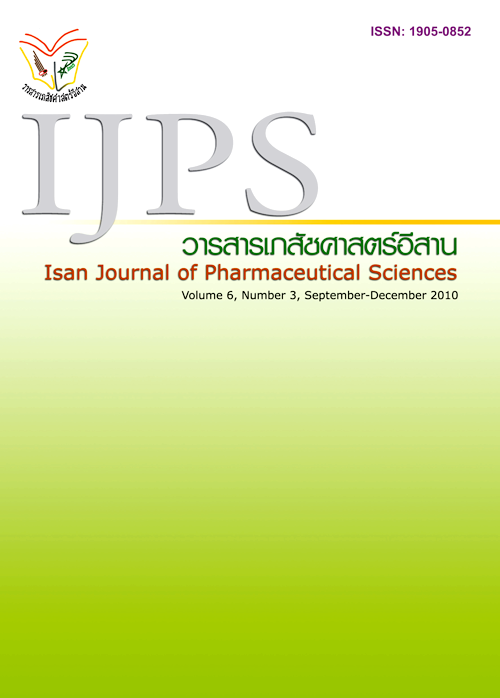Physical and Biological Properties of Mucilage from Basella alba L. Stem and Its Gel Formulation
Main Article Content
Abstract
Basella alba Linn is a succulent mucilage plant in Basellaceae family. Its mucilage is the water soluble polysaccharide. The aqueous extracts from stem of Basella alba Linn were investigated for the general physical properties and pharmacological activities. Lyophilized mucilage extract was hygroscopic and could swell in water with a swelling capacity of 4.33 + 0.29 mL/g dry weight. Its aqueous solution was viscous with pH 5.3-5.4 and film forming upon drying. The TLC analysis of hydrolyzed polysaccharide which was purified by using anion exchange chromatography yielded D-galactose as the major component. Basella alba extract presented antioxidant activity by DPPH scavenging assay (IC50 = 514.41 μg/mL) but not antityrosinase. The mucilage extract 2 mg/mL exhibited relatively mild toxicity to Chang liver cell with 84.4% cell viability. Preliminary gel formulations from Basella mucilage for further development as cosmetic and topical medicine showed good physical properties and stability.
Article Details
In the case that some parts are used by others The author must Confirm that obtaining permission to use some of the original authors. And must attach evidence That the permission has been included
References
Akhter S, Abdul H, Shawkat IS, Swapan KS, Mohammad SHC Sanjay SS. A review on the use of non-timber forest products in beauty-care in Bangladesh. J Forestry Res2008; 19: p.72-78.
Chan ECW, Lim YY, Wong LF, et al. Antioxidant and tyrosinase inhibition properties of leaves and rhizomes of ginger species. Food Chem 2008;109: p.477-483.
Dracelos ZD. Botanicals as topical agents. Clin Dermatol 2001; 19: p.474-477.
Fu YC, Ferng LH, Huang PY. Quantitative analysis of allantoin and allantoic acid in yam tuber, mucilage, skin and bulbil of the Dioscorea species. Food Chemistry 2006; 94: p.541-549.
Gerlier D, Thomasset N. Use of MTT colorimetric assay to measure cell activation. J Immunol Methods 1986; 94: p.57-63.
Glassgen WE, Metzger JW, Heuer S, Strack D. Betacyanins from fruits of Basella rubra. Phytochemistry 1993; 33: p.1525-1527.
Haq QN, Awal A, Chowdhury MK, Khan NA. Water-soluble polysaccharides from the leaves of Basella rubra. Sci Res 1969; 6: p.63-6. (Abstract)
Jadhav RB, Sonawane DS, Surana SJ. Cytoprotective effects of crude polysaccharide fraction of Abelmoschus esculentus fruits in rats. Pharmacogn Mag 2008; 4: p.130-132.
Jani GK, Shah DP, Jain VC, Patel MJ, Vithalani DA. Evaluating mucilage from Aloe Barbadensis Miller as a pharmaceutical excipient for sustained-release matrix tablets. Pharm Technol 2007; 31: p.90-98.
Khare CP. Indian medicinal plants: an illustrated dictionary. USA: Springer Science Business Media: 2007.
Kuniak L, Marchessault RH. Study of cross-linking reaction between epichlorhydrin and starch. Starch/Staerke 1972; 4: p.100 -116.
Lin A, Guo S, Chen S. Study on methods for determination of polysaccharide content from basella. Huagong Shikan 2009; 23: p.24-26. (Abstract)
Maisuthisakul P, Pasuk S, Ritthiruangdej. Relationship between antioxidant properties and chemical composition of some Thai plants. J Food Compos Anal 2008; 21: p.229-240.
Palanuvej C, Hokputsa S, Tunsaringkarn T, Ruangrungsi N. In vitro glucose entrapment and alpha-glucosidase inhibition of mucilaginous substances from selected Thai medicinal plants. Sci Pharm 2009; 77: p.837-849.
Premalatha B, Rajgopal G. Cancer-an ayurvedic perspective. Pharmacol Res 2005; 51: p.19-30.
Saikia AP, Ryakala VK Sharma P, Goswami P, Bora U. Ethnobotany of medicinal plants used by Assamese people for various skin ailments and cosmetics. J Ethnopharmacol 2006, 106: p.149-157.
Smitinand T. editor. Flora of Thailand vol.4 part 5. Bangkok: Chutima Press; 1992. p.410-412.
Toshiyuki M, Kazuhiro H, Masayuki Y. Medicinal foodstuffs. XXIII. Structures of new oleanane-type triterpene oligoglycosides, basellasaponins A, B, C, and D, from the fresh aerial parts of Basella rubra L. Chem Pharm Bull 2001; 49: p.776-779.
Tzianbos AO. Reviews: Polysaccharide immunomodulators as therapeutic agents structural aspects and biologic function. Clin Microbiol Rev 2000; 13: p.523-533.
Yen GC, Chen HY, Peng HH. Evaluation of the cytotoxicity, mutagenicity and antimutagenicity of emerging edible plants. Food Chem Toxicol2001; 39: p.1045-1053.
Zhang M, Cui SW, Cheung PCK, Wang Q. Antitumor polysaccharides from mushrooms: a review on their isolation process, structural characteristics and antitumor activity. Trends in Food SciTech 2007; 18: p.4-19.


